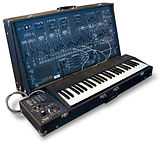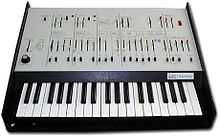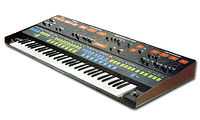ARP Instruments
ARP Instruments, Inc. was an American manufacturer of electronic musical instruments, founded by Alan Robert Pearlman[1][2][note 1] in 1969. Best known for its line of synthesizers that emerged in the early 1970s, ARP closed its doors in 1981 due to financial difficulties. The company earned a reputation for producing excellent sounding, innovative instruments and was granted several patents for the technology it developed. Almost three and a half decades after it closed its doors, the company's second flagship instrument, the ARP Odyssey, has been brought back into production by Korg Inc, working in collaboration with David Friend, Alan Pearlman's co-founder at ARP.[3]

History

Alan Pearlman was an engineering student at Worcester Polytechnic Institute, Massachusetts in 1948 when he foresaw the coming age of electronic music and synthesizers. He wrote:
- "The electronic instrument's value is chiefly as a novelty. With greater attention on the part of the engineer to the needs of the musician, the day may not be too remote when the electronic instrument may take its place ... as a versatile, powerful, and expressive instrument."
Following 21 years of experience in electronic engineering and entrepreneurship, Alan Pearlman founded ARP Instruments in 1969 with US$100,000 of personal funds and a matching amount from investors, with fellow engineering graduate David Friend on board from the beginning as the co-founder of the company.


Throughout the 1970s, ARP was the main competitor to Moog Music and eventually surpassed Moog to become the world's leading manufacturer of electronic musical instruments. There were two main camps — the Minimoog players and the ARP Odyssey/ARP 2600 players — with most proponents dedicated to their choice, although some players decided to pick and choose between the two for specific effect, as well as many who dabbled with products produced by other manufacturers. Notably, the ARP 2500 was featured in the hit movie Close Encounters of the Third Kind; ARP's Vice President of Engineering, Phillip Dodds, was sent to install the unit on the movie set and was subsequently cast as Jean Claude, the musician who played the now famous 5-note sequence on the huge synthesizer in an attempt to communicate with the alien mothership.

The demise of ARP Instruments was significantly influenced by the ill-fated decision to invest a significant amount of capital in the development of the ARP Avatar, a synthesizer module virtually identical to the ARP Odyssey sans keyboard and intended to be played by a solid body electric guitar via a specially-mounted hexaphonic guitar pickup whose signals were then processed through discrete pitch-to-voltage converters. Although an excellent, groundbreaking instrument by all accounts, the Avatar failed to sell well. ARP Instruments was never able to recoup the research and development costs associated with the Avatar project and, after several more attempts to produce successful instruments such as the ARP Quadra, ARP 16-Voice & 4-Voice Pianos, and the ARP Solus, the company finally declared bankruptcy in 1981.
.jpg)
%2C_National_Music_Centre.jpg)
During the liquidation process, the company's assets and the rights to the manufacture of the 4-Voice Piano and also the prototype ARP Chroma - the company's most sophisticated instrument design to date - were sold to CBS Musical Instruments for the total sum of $350,000. The project was completed at CBS R&D, and the renamed Rhodes Chroma was produced from 1982 to late 1983. The instrument is notable for a very flexible voice architecture; 16-note polyphony; a high-quality weighted, wooden keyboard action; pioneering use of a single slider parameter editing system (subsequently implemented on the Yamaha DX7); and the inclusion of a proprietary digital interface system that predated MIDI.
The company's (second) flagship instrument, the ARP Odyssey, has been revived in 2015, by Korg Inc.[4] The ARP2600 is currently available as a virtual instrument from the French company Arturia[5] and the Arp Odyssey is available in a modified form as the Ohm Force Oddity,[6] updated by GForce Software to a polyphonic version (the Oddity 2).[7]
Product highlights
- 1969 - ARP 2002
- 1970 - ARP 2500 (large and complex analog modular synthesizer, patched with a switch matrix, noted for its reliable tuning compared to competitors Moog and Buchla. Almost identical to the ARP 2002, except that the upper switch matrix had 20 buses instead of 10.)
- 1970 - ARP Soloist (small, portable, monophonic preset, aftertouch sensitive synthesizer)
- 1971 - ARP 2600 (smaller, more portable analog semi-modular synthesizer, pre-patched and patchable with cables)
- 1972 - ARP Odyssey (pre-patched analog duophonic synthesizer, a truly portable performance instrument, a competitor of the Minimoog); former Deep Purple keyboardist, the late Jon Lord, played an ARP Odyssey.
- 1972 - ARP Pro Soloist (small, portable, monophonic preset, aftertouch sensitive synthesizer - updated version of Soloist)
.jpg)

- 1974 - ARP String Ensemble (polyphonic string voice keyboard manufactured by Solina)
- 1974 - ARP Explorer (small, portable, monophonic preset, programmable sounds)
- 1975 - ARP Little Brother (keyboardless monophonic expander module)


- 1975 - ARP Omni (polyphonic string synthesizer with rudimentary polyphonic synthesizer functions)


- 1975 - ARP Axxe (pre-patched single oscillator analog synthesizer)
- 1975 - ARP String Synthesizer (a combination of the String Ensemble and the Explorer)
- 1977 - ARP Pro/DGX (small, portable, monophonic preset, aftertouch sensitive synthesizer - updated version of Pro Soloist)
- 1977 - ARP Omni-2 (polyphonic string synthesizer with rudimentary polyphonic synthesizer functions - updated version of Omni)
- 1977 - ARP Avatar (an Odyssey module fitted with a guitar pitch controller)
- 1978 - ARP Quadra (4 microprocessor-controlled analog synthesizers in one)
- 1979 - ARP Sequencer (analog music sequencer)
- 1979 - ARP Quartet (polyphonic orchestral synthesiser not manufacted by ARP - just bought in from Siel and rebadged )
- 1980 - ARP Solus (pre-patched analog monophonic synthesizer)
- 1981 - ARP Chroma (microprocessor controlled analog polyphonic synthesizer - sold to CBS/Rhodes when ARP closed)
Notable clients
Some notable ARP users and endorsers include:
- Tony Banks of Genesis played an ARP 2500,[8] an ARP Pro Soloist (on the album Selling England by the Pound) and later an ARP Quadra.[9]
- Marilyn Manson is listed as using an "ARP synthesizer" in the album Mechanical Animals.
- David Bowie is listed as using an "arp" in the album Low.[10]
- the BBC Radiophonic Workshop's Peter Howell used an ARP ODYSSEY to update the Dr.Who TV theme in the early 1980s.[11]
- Vince Clarke playes an ARP 2500, two ARP 2600 and two ARP Sequencer.[12]
- Chick Corea played an ARP Odyssey on the album My Spanish Heart.[13]
- Paul Davis played an ARP Odyssey, ARP 2500, ARP 2600 and ARP Quadra.[14]
- Gordon Langford produced the album The Amazing Music of the Electronic Arp Synthesizer in 1974.
- Depeche Mode use an ARP 2600.[15]
- Devo used an ARP Odyssey on their Freedom of Choice tour. Vocalist/keyboardist, Mark Mothersbaugh reported that the instrument broke down in such a way that it created an entirely new sound which would have been otherwise impossible to achieve. The "broken down" Odyssey is apparently featured in the Duty Now for the Future song, "Pink Pussycat".[16]
- Dennis DeYoung of Styx played an "Arp" on the album Styx II.[17]
- Daryl Dragon of Captain & Tennille played an ARP String Ensemble on the album Love Will Keep Us Together.[18]
- George Duke played an ARP Odyssey on the album Guardian Of The Light.[19]
- Brian Eno is listed as playing "report arp" in David Bowie's album Low.[10]
- Dave Formula played an ARP Odyssey.[20]
- Jean Michel Jarre played an ARP 2500.[8] On the album Equinoxe he played an ARP 2600 and an ARP Sequencer.[21]
- Elton John played an ARP String Ensemble in the album Captain Fantastic and the Brown Dirt Cowboy.[22]
- Herbie Hancock played an ARP Odyssey, an ARP Soloist and ARP 2600[23][24] and an ARP strings in the album Thrust.[25]
- Steve Hillage played an "Arp" on the album Rainbow Dome Musick.[26]
- Miquette Giraudy played an ARP Omni on Steve Hillage's album Rainbow Dome Musick.[26]
- The Grateful Dead[27]
- Rick van der Linden of Ekseption played an ARP 2600 on the album Trinity.[28]
- Kerry Livgren and Steve Walsh of Kansas use an "Arp" on the album Song for America.[29]
- Scott McCaughey plays an ARP Odyssey on several songs on R.E.M.'s New Adventures In Hi-Fi.[30]
- Christine McVie of Fleetwood Mac played an ARP String Ensemble on the album Heroes Are Hard To Find and on "Rumours", notably her composition Don't Stop.[31]
- Hugo Montenegro played an ARP 2500.[8]
- Gary Numan played an ARP Pro Soloist on the album Telekon.[32]
- Jimmy Page played an ARP 2500.[8]/[33]
- Anthony Phillips played an ARP String Ensemble and ARP Pro Soloist on his 1977 album The Geese and the Ghost. The album's title derived from Phillips' nicknames for two sounds he produced on the Pro Soloist, both of which feature on the title track.[34]
- Eliane Radigue played an ARP 2500 on the album Triptych.[35]
- Klaus Schulze played an ARP Odyssey and an ARP 2600 in the album Picture Music.[36]
- Kraftwerk used an ARP Odyssey on the album Autobahn.[37] The band also used an ARP Omni 1 on various albums and live performances[37]
- Dave Sinclair and Rupert Hine played an "Arp" in Caravan's album For Girls Who Grow Plump in the Night.[38]
- Gerald Shapiro played an ARP 2500.[8]
- Skinny Puppy played an ARP 2600 on their early releases[39] and an ARP 2500 and 2600 are currently in use at Subconscious Communications.[40]
- Steven Spielberg used an ARP 2500 in the movie Close Encounters of the Third Kind.[8]
- Pete Townshend of The Who wrote the song Won't Get Fooled Again on an ARP 2500.[8][23][41]
- Joe Walsh played an "Arp" on the album Barnstorm.[42]
- Edgar Winter used the ARP 2600 on the rock classic Frankenstein [23]
- Stevie Wonder used a custom Braille 2600.[43]
- Joe Zawinul of Weather Report used two[44] ARP 2600s[23] and later an ARP Quadra and an ARP Chroma.[45]
- Tod Dockstader used an ARP Axxe and an ARP String Ensemble, along with a Minimoog to create the albums Electronic Vols. 1 & 2, originally for Boosey & Hawkes
- Zodiac (band) used ARP Odyssey and ARP Omni.
Footnotes
- ↑ The name of founder Alan Robert Pearlman seems to be sometimes possibly incorrectly described as "Alan Richard Pearlman", as seen as below:
- "'Alan Richard Pealrman': 4 results". Google Books Search.
- Eberhard Höhn (1979). Elektronische Musik: Klangfarben, Klangentwicklung, Klangspiele. Hueber-Holzmann. p. 120.
ARP: Amerikanischer Synthesizerhersteller, benant nach dem Begründer Alan Richard PEARLMAN.
References
- ↑ "'Alan Robert Pealrman': 9 results". Google Books Search.
- ↑ High Fidelity (ABC Leisure Magazines) 28 (1-6): 114. 1978. Missing or empty
|title=(help) - ↑ "The resurrection of ARP by Korg". arpsynth.com. May 2014. Retrieved 28 February 2015.
- ↑ "Korg Announces the development of the ARP Odyssey synthesizer". Korg. Retrieved 17 February 2014.
- ↑ http://arturia.com/products/analog-classics/arp2600v
- ↑ https://www.ohmforce.com/ViewProduct.do?p=Oddity
- ↑ http://www.gforcesoftware.com/products/oddity2
- ↑ 8.0 8.1 8.2 8.3 8.4 8.5 8.6 "CLOSE ENCOUNTERS OF THE ARP KIND". soundonsound.com. August 1996. Retrieved 3 August 2010.
- ↑ "Korg Oasys: On Tour with Tony Banks and Genesis". dv247.com. Retrieved 3 August 2010.
- ↑ 10.0 10.1 "David Bowie - Low (CD, Album) at Discogs". discogs.com. Archived from the original on 8 August 2010. Retrieved 3 August 2010.
- ↑ http://www.youtube.com/watch?v=dRYQEmwPJjQ.
- ↑ "Vince Clarke Music • Studio". vinceclarkemusic.com. Archived from the original on 17 July 2010. Retrieved 3 August 2010.
- ↑ "Chick Corea - My Spanish Heart (CD, Album) at Discogs". discogs.com. Retrieved 3 August 2010.
- ↑ Keyboard Magazine: 33. March 1977. Missing or empty
|title=(help) - ↑ Miller, Johnathan (2004). Stripped: The True Story of Depeche Mode. Omnibus Press. pp. 247–248. ISBN 1-84449-415-2.
- ↑ "Sonic talk to DEVO". youtube.com. Retrieved 14 May 2012.
- ↑ "Styx - Styx II (Vinyl, LP) at Discogs". discogs.com. Retrieved 3 August 2010.
- ↑ "Captain And Tennille - Love Will Keep Us Together (Vinyl, LP, Album) at Discogs". discogs.com. Retrieved 3 August 2010.
- ↑ "George Duke - Guardian Of The Light (Vinyl, LP) at Discogs". discogs.com. Retrieved 3 August 2010.
- ↑ "YouTube - Dave Formula's Custom Prodyssey". youtube.com. Retrieved 3 August 2010.
- ↑ "Jean Michel Jarre - Equinoxe (CD, Album) at Discogs". discogs.com. Retrieved 3 August 2010.
- ↑ "Elton John - Captain Fantastic And The Brown Dirt Cowboy (Vinyl, LP) at Discogs". discogs.com. Retrieved 3 August 2010.
- ↑ 23.0 23.1 23.2 23.3 Holmes, Thom (2008). Electronic and Experimental Music: Technology, Music, and Culture. Routledge. p. 247. ISBN 0-415-95782-6.
- ↑ Rideout, Ernie (2008). Keyboard Presents the Best of the 80's. Backbeat. p. 69. ISBN 0-87930-930-X.
- ↑ "Herbie Hancock - Thrust (CD, Album) at Discogs". discogs.com. Archived from the original on 16 September 2010. Retrieved 3 August 2010.
- ↑ 26.0 26.1 "Steve Hillage - Rainbow Dome Musick (CD, Album) at Discogs". discogs.com. Retrieved 3 August 2010.
- ↑ Jackson, Blair (2006). Grateful Dead Gear - The Band's Instruments, Sound Systems, and Recording Sessions, From 1965 to 1995. Backbeat Books. p. 190. ISBN 0-87930-893-1.
- ↑ "Ekseption - Trinity (Vinyl, LP, Album) at Discogs". discogs.com. Retrieved 3 August 2010.
- ↑ "Kansas (2) - Song For America (CD, Album) at Discogs". discogs.com. Retrieved 3 August 2010.
- ↑ "R.E.M. - New Adventures In Hi-Fi (CD, Album) at Discogs". discogs.com. Retrieved 9 April 2011.
- ↑ "Fleetwood Mac - Heroes Are Hard To Find (Vinyl, LP, Album) at Discogs". discogs.com. Retrieved 3 August 2010.
- ↑ "Gary Numan - Telekon (Vinyl, LP, Album) at Discogs". discogs.com. Retrieved 3 August 2010.
- ↑
- ↑ Dann, Jonathan. "Anthony Phillips FAQ". Retrieved 15 December 2012.
- ↑ "Eliane Radigue - Triptych (CD) at Discogs". discogs.com. Retrieved 3 August 2010.
- ↑ "Klaus Schulze - Picture Music (Vinyl, LP, Album) at Discogs". discogs.com. Retrieved 3 August 2010.
- ↑ 37.0 37.1 http://kraftwerkfaq.hu/equipment.html
- ↑ "Caravan - For Girls Who Grow Plump In The Night (Vinyl, LP, Album) at Discogs". discogs.com. Archived from the original on 2 September 2010. Retrieved 3 August 2010.
- ↑ Future music, Issues 113-117. Larpress. 2001. p. 104.
- ↑ Justin Kleinfeld (April 1, 2004). "Skinny Puppy on recording and producing The Greater Wrong of the Right". Electronic Musician Magazine. Retrieved 3 August 2010.
- ↑ YouTube video of Pete Townshend demonstrating it
- ↑ "Joe Walsh - Barnstorm (Vinyl, LP, Album) at Discogs". discogs.com. Retrieved 3 August 2010.
- ↑ Vail, Mark (2000). Vintage Synthesizers: Pioneering Designers, Groundbreaking Instruments, Collecting Tips, Mutants of Technology. Miller Freeman Books. p. 125. ISBN 0-87930-603-3.
- ↑ Baraka, Imamu (1976). "Weather Report". Down Beat Magazine 43: 46.
- ↑ "Zawinul Online - Keyboards". zawinulonline.org. Retrieved 26 February 2012.
External links
| Wikimedia Commons has media related to ARP synthesizers. |
- The Rise and Fall of ARP Instruments (article from April 1983, Keyboard Magazine)
- Arp continued into Virtual Instruments Arp 2600 and Arp Axxe (Kikaxxe) at wayoutware.com WOW!
- Films and pictures of the Arp Solina
- ARP Instruments at Synthmuseum.com
- Retrosound - ARP Odyssey and Solina String Ensemble pics and info
- Solina VSTi plugin
- Arp Odyssey page with sounds and pics